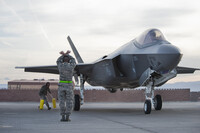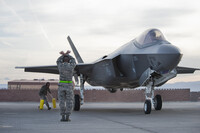F-35 non è chiaramente pronto per il debutto: vice ammiraglio David Venlet si chiede se è tempo di staccare la spina al caccia F-35

"Molti sacrifici, ma italiani capiranno". (Primo Ministro Mario Monti)
Sono anni, mese dopo mese, che gli italiani tentano di spiegare ai vari governi che la crescita del debito pubblico è dovuta in buona misura alle spese militari del Paese. Si è chiesto cosa ne fa l'Italia di 131 F-35 e perché mai dovremmo spendere più di 18 miliardi di denaro pubblico per un programma che gli americani stessi mettono in discussione. Perché comprare un nuovo caccia che ha come unico compito quello dell'attacco?
Abbiamo cercato di ottenere una risposta e abbiamo cercato di spiegare che altrove si stanno facendo le stesse domande. Forse non ci hanno capito. Proviamo a raccontarlo con la lingua inglese e a farlo attraverso illustri loro "colleghi". Chissà se così ci capiranno.
Expert wonders if it's time to put F-35 out of its misery
JSF's Build And Test Was 'Miscalculation,' Adm. Venlet Says; Production Must Slow
Air Force Secretary Agrees JSF Not Ready For Training
Some things have come into sharper focus about the state of the F-35 Joint Strike Fighter program in the wake of both Vice Adm. David Venlet's interview with AOL Defense and a story Monday by Tony Capaccio of Bloomberg News (subscription).
The first is that in almost 10 years of development, and despite a reportedly strong period of successful flight testing, is that the airplanes are apparently still far from ready for even really challenging testing. With 90-plus F-35s of the three variants -- really very different planes -- already built or in production, much, much more development and testing remains and, we know now, re-work too.
The much-touted ability of Lockheed Martin and its key partners to concurrently design, develop and build production aircraft was, to put it kindly, way, way oversold.
Venlet said as much in his interview last week.
"Fundamentally that was a miscalculation," Venlet said. "You'd like to take the keys to your shiny new jet and give it to the fleet with all the capability and all the service life they want. What we're doing is, we're taking the keys to the shiny new jet, giving it to the fleet and saying, 'Give me that jet back in the first year. I've got to go take it up to this depot for a couple of months and tear into it and put in some structural mods, because if I don't, we're not going to be able to fly it more than a couple, three, four, five years.' That's what concurrency is doing to us."
Lockheed, in a statement, disagreed with Venlet and defended concurrent development and production.
The concurrency costs for F-35 continue to reduce for each lot as experienced by all fighter aircraft development programs. Going forward the savings associated with building at increased production rates will continue to mitigate the diminishing concurrency costs.
Capaccio's story, based on an internal Pentagon document of the kind he has a knack for getting his hands on, shed's a even more light.
In one recent month, apparently October, there were 725 pending design "change requests," according to the Bloomberg piece. “These figures are indicative of the large volume of change on this program and low design maturity,” it said.
The Star-Telegram has recently requested information from the program office on numbers of engineering change orders, and who initiated them, but has yet to get any response.
Bloomberg cited some of the existing problems spotlighted in the Pentagon report, which is being studied by policy makers as they plan how to proceed with the F-35 program.
One of the big problems is with the tail hook arresting gear mechanism on the F-35C that is supposed to bring the planes to a screeching halt in landings aboard Navy carriers.
The tail hook mechanism failed all eight landing attempts in tests and requires significant and, apparently, challenging redesign of the system and perhaps the aircraft structure itself. “If this change is not successful there is risk for significant airframe structures redesign and or impacts to overall” radar signature, the report said.
The U.S. Air Force has apparently also has come to the conclusion it's a little too early to let anyone but its test pilots fly the F-35. InsideDefense.com reports (pay-per-view) that Air Force Secretary Michael Donley has agreed with Director of Operational Testing Michael Gilmore that the F-35 is not ready to begin pilot training at Eglin Air Force Base in Fla.
"The Air Force agreed with Dr. Gilmore that there were still outstanding risks associated with the Joint Strike Fighter flight training at Eglin AFB," according to a summary of a memo Donley sent to Frank Kendall, DOD's acting head of weapons acquisition. "We emphasized that a military flight release (MFR), which would permit flight operations to begin, will not be issued, and subsequently training in [conventional-takeoff-and-landing] aircraft will not commence, until these risks have been accepted or mitigated using established processes."
As with most big defense programs, to paraphrase Texas songwriter Robert Earl Keen, "The road goes on forever" and the debate never ends. Defense critic Winslow Wheeler of the Center for Defense Information said Tuesday "the smart thing to do is put this airplane out of its misery" but doubts DoD has the political will to do that.
But a former U.S. National Security Council staff member and defense consultant Robbin Laird says critics, notably Sen. John McCain, can't see the future from the past and are ignoring the great strides in military capabilities the F-35 will eventually bring to U.S. forces.
Articoli correlati
 Albert - bollettino pacifista dal 24 al 30 marzo 2025
Albert - bollettino pacifista dal 24 al 30 marzo 2025Sparano sulle ambulanze
E’ stata una settimana di mobilitazione quella appena finita, con i pacifisti nuovamente in piazza contro la barbarie. Non si può rimanere indifferenti per uno sterminio che a Gaza non ha fine. E contemporaneamente cresce una forte opposizione al piano di riarmo della von der Leyen e della Meloni.30 marzo 2025 - Redazione PeaceLink Ma l'onda pacifista cresce
Ma l'onda pacifista cresceAtteso in Parlamento il piano di acquisto dei nuovi F-35
Ben 7 miliardi per l'acquisto di venticinque nuovi F-35. Contro questo piano di spreco del denaro pubblico e contro il piano di riarmo europeo a Bari sono scese in piazza tante persone e tante realtà associative.30 marzo 2025 - Redazione PeaceLink Situata in Puglia, nella provincia di Foggia, è la più grande base aerea italiana
Situata in Puglia, nella provincia di Foggia, è la più grande base aerea italianaLa base aerea di Amendola e il suo ruolo nella guerra nucleare
Ospita gli F-35 che possono trasportare le testate nucleari. E' integrata con la base di Ghedi e Aviano che ospitano le bombe nucleari B61-12. I piloti degli F-35 italiani vengono addestrati per missioni di attacco nucleare sotto comando USA presso le basi di Luke (Arizona) ed Eglin (Florida).30 gennaio 2025 - Redazione PeaceLink Previsti 5.660 posti in meno per il personale docente e un taglio di 2.174 unità per personale ATA
Previsti 5.660 posti in meno per il personale docente e un taglio di 2.174 unità per personale ATAPer far volare gli F-35 il governo taglia gli insegnanti
Lo stipendio mensile lordo annuo di un insegnante è di 30 mila euro/anno. Ben al di sotto del costo di un'ora di volo di un F-35 che sfiora i 42 mila dollari. E così per far volare gli F-35 nell'Indopacifico, non lontano dalle coste della Cina, il governo taglia gli insegnanti.24 gennaio 2025 - Redazione PeaceLink
Sociale.network